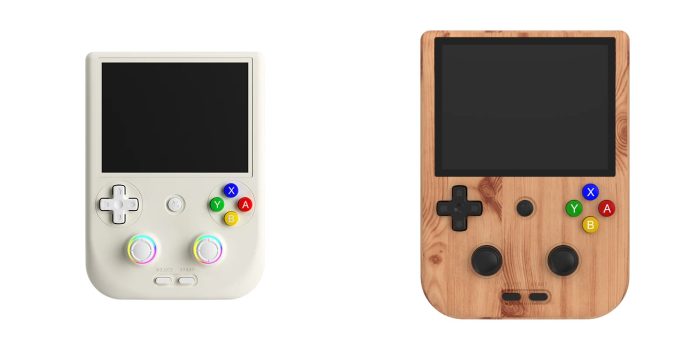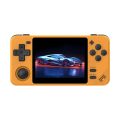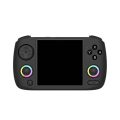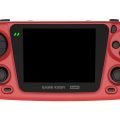As a big fan of retro handheld consoles, I’ve had the pleasure of testing out the latest Anbernic RG406V and putting it side by side with its predecessor, the RG405V. Both consoles offer a vertical format, run on Android, and promise strong emulation capabilities for retro games. However, there are notable differences in design, performance, and gaming experience. Let’s explore the pros, cons, and platform differences, so you can make the best choice for your gaming needs.
Design and Build Quality
The RG406V, Anbernic’s latest handheld, is an evolution of the RG405V. The RG406V features upgraded analog sticks with backlighting, better ergonomics with curved grips, and improved ventilation. These changes make it more comfortable to hold for long sessions compared to the RG405V.
Display Quality
Both consoles sport a similar vertical screen format, but the RG406V has a slight edge in terms of display clarity. Colors on the RG406V are more vibrant, and the contrast levels make games look more immersive, especially on higher-end graphics for PSP or Dreamcast games. Though the RG405V’s display is still quite good, it falls a bit short compared to the rich color and contrast of the RG406V. For gamers who appreciate visual quality, the RG406V is the clear winner.
Another great feature of the RG406V is its HDMI output capability. By connecting it to an external screen, you can experience games on a bigger display—a useful perk if you want to switch between handheld and big-screen gaming. The RG405V also has HDMI output, but the RG406V’s output quality seems slightly sharper in 16:9 mode, making it a better choice for playing on a TV or monitor.
Operating System and Usability
Both the RG405V and RG406V run on Android, which is great for flexibility in emulation. The RG406V ships with Android 13, offering a smoother experience and better compatibility with recent apps and updates compared to the older Android version on the RG405V.
The user interface on the RG406V is well thought-out, with features like customizable themes and LED options for the joystick lights. Adding games is straightforward—just download a file manager from the Google Play Store, create folders for each console, and add your game ROMs. A slight drawback on both devices is the lack of an integrated game scrapper, so you’ll need to download game cover art and metadata manually.
For those familiar with the RG405V, you might already know about the custom firmware, GammaOS, which is an option worth considering. GammaOS offers better overall performance on the RG405V by optimizing drivers and smoothing out issues with frame rates, particularly on high-demand emulations like PlayStation 2. Though the RG406V doesn’t have a custom OS like GammaOS yet, its stock firmware performs efficiently, and it’s highly likely that custom firmware will be developed in the future.
Emulation Performance
Performance is where the RG406V and RG405V show their differences more starkly. The RG406V has a faster T820 processor and 8GB of RAM, while the RG405V features a T618 processor and 4GB of RAM. In theory, this should give the RG406V an advantage in handling more demanding games, especially for emulating PS2 and PSP titles.
However, in actual performance tests, the difference isn’t always night and day. Both consoles handle the classics—8-bit, 16-bit, and PlayStation 1—effortlessly. Moving to the more demanding systems like PlayStation 2, the RG406V does pull ahead, particularly in FPS stability. On graphically intense games such as Shadow of the Colossus and God of War 2, the RG406V edges out the RG405V in terms of smoother frame rates and fewer stutters, even without custom firmware.
If you’re running GammaOS on the RG405V, however, it manages to keep up surprisingly well with the RG406V on most titles. For instance, on games like GTA: San Andreas and Silent Hill 2, performance is nearly identical, with both devices hitting playable frame rates. The RG406V still wins in heavy processing situations, but the difference may not be as significant if you’ve optimized the RG405V.
Battery Life and Cooling
Battery life is decent on both models, though the RG406V might last a bit longer due to better power management. I’ve been able to get around six hours on both consoles while playing retro games, but more demanding emulation reduces this to about four hours. Since both have customizable power settings, you can adjust performance to stretch battery life slightly longer if needed.
The RG406V has a better cooling system overall, and it rarely gets as warm as the RG405V during extended gaming sessions. The fan on the RG406V seems to be more effective and quieter, which is a nice touch for longer sessions, especially when emulating high-demand titles.
Game Library and Compatibility
If you’re looking to emulate platforms like NES, SNES, Sega Genesis, or even Nintendo 64, both consoles can handle them without breaking a sweat. The RG406V and RG405V offer reliable emulation across a wide range of consoles, including PlayStation, Dreamcast, PSP, and GameCube. Both devices provide an impressive lineup, and with Android, you have access to multiple emulators to expand compatibility even further.
While the RG406V has the advantage in handling more demanding systems like PlayStation 2, the RG405V isn’t far behind when running GammaOS. That said, the RG406V does have a bit more “headroom” for future updates or potentially heavier games.
Pros and Cons
Anbernic RG406V Pros:
- Superior joystick quality and overall build
- Better display with higher contrast and color accuracy
- Strong performance on high-demand emulators like PS2
- Excellent cooling system and quiet fan operation
- HDMI output with good performance on a larger screen
Anbernic RG406V Cons:
- Lack of custom firmware options for now
- No integrated scrapper for game cover art
Anbernic RG405V Pros:
- Smooth performance with GammaOS installed
- Solid emulation across all major retro platforms
- Lower fan noise with GammaOS optimization
- Similar HDMI output capability to the RG406V
Anbernic RG405V Cons:
- Lower contrast and color quality in the display
- Joysticks are not as advanced or responsive as those on the RG406V
- Slightly weaker cooling system and occasional warm-up on intensive games
Frequently Asked Questions
1. What’s the main difference in design between the RG406V and RG405V?
The RG406V features upgraded analog sticks with backlighting, better ergonomics with curved grips, and improved ventilation. These changes make it more comfortable to hold for long sessions compared to the RG405V.
2. Does the RG406V have better screen quality than the RG405V?
Yes, the RG406V has a higher-definition screen with enhanced color and contrast, providing more vibrant visuals. The RG405V screen is decent, but the RG406V offers noticeably better clarity and display quality.
3. How do the joysticks differ between the RG406V and RG405V?
The RG406V uses updated joysticks similar to those in high-end gaming devices, which offer a smoother and more responsive experience. The RG405V has joysticks similar to those on the Nintendo Switch, which are functional but not as refined.
4. What are the processor and RAM differences between the two consoles?
The RG406V is powered by a T820 processor with 8GB of RAM, while the RG405V has a T618 processor and 4GB of RAM. This boost in processing power allows the RG406V to handle more demanding emulation tasks with less lag.
5. Which console is better for emulating PlayStation 2 games?
The RG406V handles PS2 emulation slightly better out of the box, thanks to its upgraded hardware. However, the RG405V, when running custom firmware like GammaOS, can perform nearly as well in many PS2 games.
6. Is there any fan noise difference between the RG406V and RG405V?
Yes, the RG406V has a quieter and more effective cooling system. The RG405V’s fan can get a bit louder during intense gaming sessions, while the RG406V stays cooler and quieter overall.
7. Can both consoles connect to a larger screen?
Yes, both the RG406V and RG405V support HDMI output, allowing you to connect them to a TV or monitor for a bigger gaming experience. The RG406V offers slightly better output quality, especially in 16:9 mode.
8. Do the consoles come with a game cover scraper?
No, neither the RG406V nor RG405V has an integrated game scraper. To add cover art for games, users need to download and install the images manually.
9. What operating systems do the RG406V and RG405V run on?
Both consoles run on Android. The RG406V comes with Android 13, while the RG405V has an older version of Android. This gives the RG406V an edge in compatibility with newer apps and updates.
10. How does the battery life compare between the two consoles?
Battery life is similar, with around six hours for retro games and about four hours for high-demand emulation. Both consoles have power settings that can help stretch battery life further if needed.
11. What’s GammaOS, and how does it improve the RG405V?
GammaOS is a custom firmware available for the RG405V that enhances performance and frame rates, particularly for more demanding games like PS2 titles. It optimizes drivers, making the RG405V run smoother and quieter, rivaling the RG406V in some cases.
12. Is the RG406V’s display noticeably better for older games?
Yes, the RG406V’s display offers sharper resolution, better contrast, and color, enhancing the look of both retro and newer games. The RG405V’s display quality is good, but the improved visuals on the RG406V make a difference.
13. Which console should I choose if I already have an RG405V?
If you already own an RG405V and have it set up with GammaOS, upgrading to the RG406V might not be necessary. However, if you want the added display quality, cooling improvements, and better joysticks, the RG406V could be worth considering.
14. What gaming platforms can both consoles handle well?
Both consoles perform well with emulation for platforms like NES, SNES, Sega Genesis, PlayStation, Dreamcast, PSP, and GameCube. They offer smooth experiences across these retro systems with no major issues.
15. Does the RG406V handle intensive games better than the RG405V?
Generally, yes. The RG406V’s upgraded hardware helps it handle high-demand games more smoothly. However, the RG405V running GammaOS comes close in performance, especially for PS2 titles, so the difference is subtle.
Final Verdict
If you’re new to the retro handheld scene or want a powerful device with a more modern feel, the RG406V is the way to go. It offers smoother emulation, superior joysticks, and an overall more refined experience for current Android-based retro consoles.
However, if you already own the RG405V and have GammaOS installed, upgrading to the RG406V might not be immediately necessary unless you’re craving those quality-of-life improvements in display, cooling, and joystick feel. The RG405V holds up well with custom firmware and remains a solid choice for retro gaming.
In short, if you don’t own either, the RG406V is likely the better choice moving forward. But if you already have an RG405V, sticking with it for now isn’t a bad option—especially if you’re willing to experiment with custom firmware for enhanced performance. Both consoles deliver excellent experiences, but the RG406V is undoubtedly the next step up in Anbernic’s lineup.





